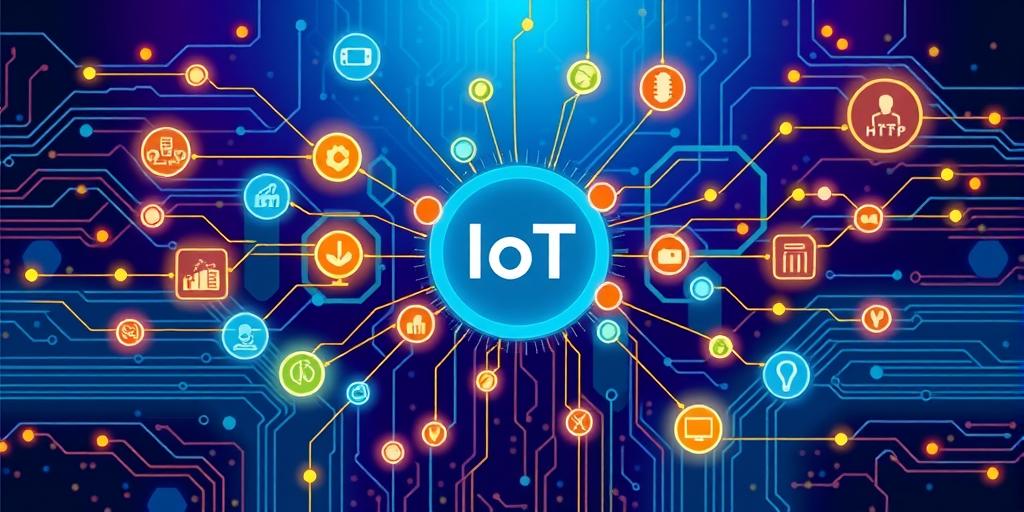Want to unlock the secrets of the Internet of Things (IoT)? Dive into the fascinating world of IoT protocols and standards – the unseen forces connecting billions of devices! From smart homes to industrial automation, understanding these fundamental elements is crucial for anyone navigating the rapidly expanding IoT landscape. This comprehensive guide demystifies the key protocols and standards, empowering you to make informed decisions and build your own IoT systems with confidence. Prepare to be amazed by the interconnectedness of it all!
Decoding the Language of IoT: Key Protocols
The Internet of Things isn’t just a collection of devices; it’s a complex ecosystem communicating through various protocols. These protocols dictate how devices exchange data, ensuring seamless interoperability. Let’s explore some of the most prominent players:
MQTT (Message Queuing Telemetry Transport): The Lightweight Champion
MQTT, often hailed as the lightweight king of IoT, is a publish-subscribe network protocol that shines in resource-constrained environments. Its minimal bandwidth requirements and simplicity make it ideal for low-power devices like sensors and actuators. MQTT’s popularity stems from its effectiveness in transmitting data across unreliable networks, making it robust and reliable even under challenging conditions. Learning MQTT is a great starting point for anyone exploring IoT development.
CoAP (Constrained Application Protocol): Designed for Resource Limits
CoAP is another excellent choice for resource-constrained devices. Designed specifically for the IoT, this protocol prioritizes low power consumption and minimal overhead. CoAP operates over UDP, offering a faster and more efficient alternative to TCP in environments where network conditions are unpredictable. Many developers find it easier to work with than some of the more complex alternatives. It’s a powerful protocol you should definitely consider.
HTTP (Hypertext Transfer Protocol): The Web Standard in IoT
You might be surprised to find HTTP on this list, but it’s indeed a key player in the IoT world. Many IoT devices use HTTP for simple data exchange, leveraging its familiarity and broad support. Although not as efficient as MQTT or CoAP for resource-constrained devices, HTTP’s ubiquity makes it a valuable protocol for IoT applications needing seamless integration with web services. There are a lot of libraries to support it making it very developer friendly.
IoT Standards: Ensuring Interoperability
While protocols define the communication mechanisms, standards ensure compatibility and interoperability among devices from various manufacturers. This is crucial for the seamless operation of large-scale IoT deployments. Here are some significant standards playing crucial roles in shaping the IoT landscape:
OneM2M: A Global Standard for IoT
OneM2M is an internationally recognized standard that aims to create a unified framework for machine-to-machine communication. It provides a robust architecture for data models, communication protocols, and security mechanisms, fostering interoperability across different platforms and systems. By following the OneM2M standards, developers can build IoT systems that work seamlessly together. Understanding OneM2M is invaluable for those looking to work on large scale IoT deployments.
Zigbee: Connecting Your Smart Home
Zigbee is a powerful wireless communication protocol specifically designed for low-power, low-data-rate applications. This makes it ideal for connecting various devices in a smart home environment, enabling smart lighting, thermostats, and other interconnected appliances to communicate effectively. Using this standard makes it easier to combine different appliances in your home environment.
Z-Wave: Another Strong Contender for Home Automation
Similar to Zigbee, Z-Wave is also designed for home automation applications. However, it offers some unique characteristics that make it stand out. Its strong mesh networking capabilities provide robust communication, even in challenging environments. Many home automation systems rely on Z-Wave for secure and reliable interconnectivity.
Choosing the Right Protocol and Standard: Factors to Consider
Selecting the appropriate protocol and standard depends on several factors such as the application’s specific requirements, the resources available on the devices, and the desired level of interoperability. Consider factors such as:
Power Consumption: Energy Efficiency Matters
Low-power protocols such as MQTT and CoAP are essential for battery-powered devices to extend their lifespan. High-power consuming protocols may be unsuitable for resource-constrained environments.
Data Rate and Bandwidth: Balancing Speed and Efficiency
Protocols with higher data rates, such as HTTP, are beneficial for applications requiring fast data transmission, while low-data-rate protocols such as Zigbee are suitable for simple sensor data.
Security: Protecting Your IoT Network
Security is paramount in IoT systems. Choose protocols and standards that provide robust security mechanisms to protect against unauthorized access and data breaches.
Embrace the Future of Connectivity
The world of IoT protocols and standards is constantly evolving, but understanding the fundamental principles is key to harnessing the full potential of this rapidly advancing technology. By understanding the key protocols and standards outlined in this guide, you’re well-equipped to build and manage your own IoT projects, confidently navigating the interconnected world of things. Start exploring today and become a master of IoT connectivity!




